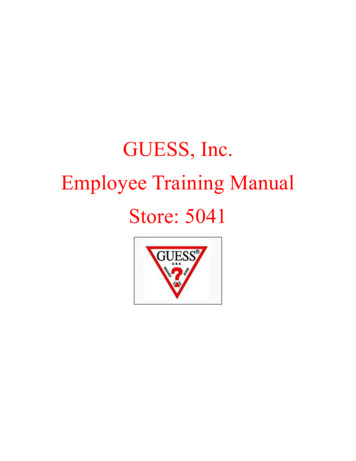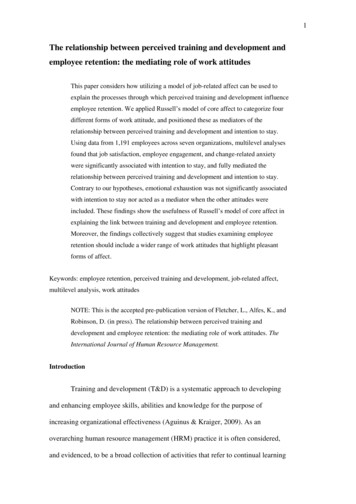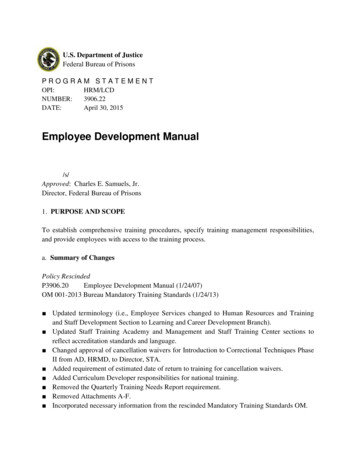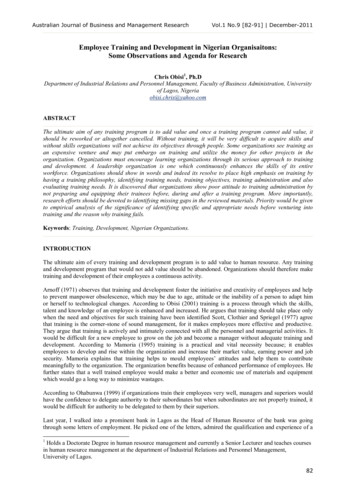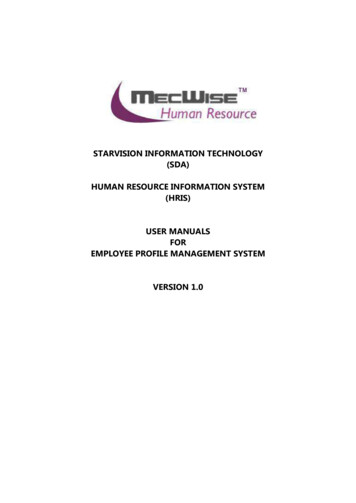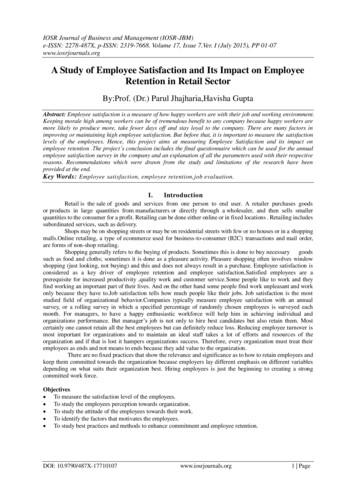
Transcription
EMPLOYEE TRAINING ANDDEVELOPMENT:How To MeasureEffectiveness and ImpactAN EBOOKBrought to you by:
DELIVERING MEANINGFUL LEARNING RESOURCES TO YOUR EMPLOYEESThe ASTD 2013 State of the Industry report shows the average cost per learning hourused is 89, and the cost per learning hour available is 1,772.Both of these metrics increased over the previous year and have been on anupward trend since 2004. The cost per learning hour used increased by 4% in 2012compared with 2011, and the cost per learning hour available increased by 20% in 1,195the same time period.Overall spending on employee training in U.S.organizations is 164 billion. How can we measure the effectiveness of our training initiatives? How can we make sure the investment of time and resources is making a positivebusiness impact?COMPANY SIZE (# of Employees)Smaller organizationstypically spend moreper employee thanlarger organizations. 700 964 1,800In this eBook we'll review: Training metrics - where we've been and where we're going How to determine goals and key indicators How to create a measurement plan for your programBIZLIBRARY.COMCOST PER EMPLOYEE PER YEAR
KEY PERFORMANCE INDICATORS AND BENCHMARKSTo get started, here are a few things to do:How do you currently measure success? Do not worry about creating new metrics. We’ll spend more time on this inlater pages, but metrics created for the sole purpose of evaluating the effectiveness of training usually don’t haveenough history or depth to be meaningful. Use your existing key performance indicators at the organizational ANDemployee level.Use your existing data to set benchmarks. It’s impossible to know how much progress you will make unless you knowclearly where to start. You have to make some smart choices, but decide which key business areas your employeetraining will target, and get benchmark data to understand the current level.HR and Training professionals can help managers and supervisors in developing effective performancegoals by taking these steps:1. Designing the goal-setting process.2. Developing forms to be used in connection with goal-setting meetings.3. Providing education and training about the following: The importance of clear and measurable goals. The elements of effective written goals. Ways to create a safe and productive environment for goal-setting. Ways to engage in goal-setting dialogue with employees.4. Establishing mechanisms to ensure that managers set, discuss, and document goals with employeesearly in the appraisal cycle.SOURCE: SHRM 2013, Developing Individual Performance GoalsBIZLIBRARY.COM
MEASUREMENT AND BUSINESSIn the 1950s, two great business thinkers and visionaries articulated somefoundational business principles that remain influential today.W. Edwards Deming began working on the post war reconstruction ofthe Japanese economy based upon persistent use of statistics to seekcontinuous improvement. His work was so valued by the Japanesegovernment that The Deming Prize was inaugurated in 1951, andremains the most prestigious business award in Japan. Deming was theforemost thought leader on the power of analytics to driveimprovement, and his work influenced an entire generation of writersand academics all around the world.“It's not enough to do your best;you must know what to do andthen do your best.”W. Edwards DemingRead more about Deming“The leaders who work mostPeter Drucker is another great business thought leader whose workremains relevant today. Drucker introduced the concept of modernbusiness management to corporate America. In 1954, he wrote one ofthe greatest books on management ever written – The Business ofManagement. He first coined the term “knowledge worker” in 1959and helped pioneer knowledge work productivity.Drucker was an advocate for rational management based uponmotivating people and a commitment to continuous learning. LikeDeming, he believed strongly in the power of data and information toinform management decisions, when the data was rational, gatheredwell and made sense.Read more about Druckereffectively, it seems to me, neversay ‘I’. And that’s not becausethey have trained themselves notto say ‘I’ . They don’t think ‘I’. Theythink ‘we’.; they think ‘team’. Theyunderstand their job to be tomake the team function. Theyaccept responsibility and don’tsidestep it, but ‘we’ gets thecredit This is what creates trusts,what enables you to get the taskdone.”Peter DruckerBIZLIBRARY.COM
MEASUREMENT AND BUSINESSIn 1959, Donald Kirkpatrick introduced the world to a rationalmethodology for measuring the impact and ROI of employee training.He published four articles called, “Techniques for Evaluating TrainingPrograms.” The Kirkpatrick Institute continues Mr. Kirkpatrick’s worktoday, and this four-step method remains the “gold standard” for mostorganizational efforts to measure the impact of employee trainingprograms 55 years since Kirkpatrick introduced it to the market.Read more about KirkpatrickIn the 1970s, Dr. Jack Phillips built upon the foundation of work begunby Donald Kirkpatrick and added a 5th level to the methodology.Phillips added a rigorous data-driven 5th layer to the techniquedesigned to illustrate business benefits derived from employee trainingefforts. Phillips remains at the head of his ROI Institute and is one of thetop thought leaders in this space.THE KIRKPATRICK – PHILLIPSMODELLEVEL 5RETURN ON INVESTMENTLEVEL 4RESULTS – business impactRead more about PhillipsLEVEL 3And that pretty well sums up the state of leadership on measuring the effectivenessof employee training. Not a lot has changed other than refinements to theKirkpatrick/Phillips method, in over 40 years.Which leads to an important question. Has the business environment changed inthose 40 years? If so, have the changes been profound enough that maybe weshould reexamine how we look at and measure the effectiveness of employeetraining efforts?BEHAVIOR - applicationLEVEL 2LEARNING – knowledge, skills andattitudesLEVEL 1REACTION – participantsatisfactionBIZLIBRARY.COM
THEN AND NOW20133D PRINTING1970FIRST FLOPPYDISK1959SPUTNIK –launch of firstmanmadesatelliteTHE AVERAGE COST OF ANEW HOUSETHE COST OF ONEGALLON OF GAS2013: 271,6002013: 3.611970: 0.361959: 0.251970: 23,5001959: 12,400
THEN AND NOWObviously, the world has changed in the last 40 years. And that begs an importantquestion. Why haven’t we changed the way we look at measuring theeffectiveness of employee training?One of the best things about baseball is that we know how to measure success.Baseball has been measuring success since the introduction of the box score in themid-19th century. Pitchers have earned run average. Hitters have batting averageand on-base percentage. There are a number of ways to measure success on abaseball field. And we can see the effect of training in these very measures, too. If apitcher learns a new pitch and it’s a good pitch, we’ll see his ERA improve. If a hitterlearns how to hit a curve ball better, we will see his batting average improve.If only corporate employee training were as easy! We train and train but can wereally tell if improvements in performance are the result of the training? Thechallenge of isolating the impact of training on improved organizationalperformance remains one of the most imposing challenges facing the professiontoday.What can we do? Walk away? Or – do we find new ways to approach thechallenge?We already know that few organizations measure the impact of employee trainingat the business impact or more sophisticated levels of the prevailing methodology.But what if we could find a simpler way to get at the actual business impact of ouremployee training efforts?BIZLIBRARY.COM“It’s not the 95% that's right thatmakes something work; it's the 5%that's wrong that messeseverything up.”Will Kaydos,Measuring, Managing andMaximizing Performance.
RETURN ON INVESTMENTBeyond the fact that so few organizations get beyond the first two levels of ROIevaluation (learner reaction, the “smile sheets”) and learning (usually measured byan assessment at the end of a course), the vocabulary of ROI focuses almostexclusively on training inputs. This is clearly true of these first two levels.Even if organizations move beyond the first two levels, the conventional methodsdo little to help us isolate the effects or improvement we can attribute to theemployee training initiative or program. Even at the top levels, the conventionalapproach requires a broad focus on organizational results alone. Such a focus isn’tall negative and is an important element of measuring the effectiveness ofemployee training efforts. Without a stronger foundation than we get from smilesheets and simple assessments after a class, we still cannot really link improvedbusiness results to the improved performance of employees gained through alearning program.Isolation TechniquesThere are three traditional techniques that can begin to tell you an important storyabout the impact of employee learning and training on organizationalperformance. All three methods have merit and can generate important,meaningful and very useful data. The illustration below helps explain the challengewe are trying to overcome. There might be any number of factors that explain whyan organization improved performance.EXTERNAL FACTORSTOTALIMPROVEMENTAFTERPROGRAMMANAGER URE CHANGESLEARNING PROGRAMBIZLIBRARY.COMEFFECT OFLEARNING ONIMPROVEMENT“What makes measurement sopotent is its capacity to instigateinformed action — to provide theopportunity for people to engagein the right behavior at the righttime.”Dean Spitzer, PHD,Transforming PerformanceMeasurement: Rethinking the Way WeMeasure and Drive OrganizationalSuccess.
RETURN ON INVESTMENTExternal factors such as market conditions or competition may have an impact, however neither of these factors haveanything to do with your employee training. Both factors could influence organizational performance. Managementmight be paying more attention to the area you are trying to improve, and this focus might have a positive impact.You might have systems or process improvements that helped improve outcomes, as well. Any of these factors mayhave been as influential on your employee training. Conversely, your employee training may have been the singlemost critical factor in the improved performance, but you won’t know unless you can isolate its impact from theimpact or influence of other factors.Trend Line AnalysisThis is a great way to get a big picture perspective on how your organization is doing before, during and after traininginitiatives. The key to an effective trend line analysis is to examine performance along a long enough time frame toprovide a complete picture of success and gaps both before and after training initiatives start.Start your trend line analysis at a meaningful time interval before you launch your training effort. In order to do this, youneed to be committed to measuring the business impact of training using existing key performance indicators.Here is a specific example of how this might work.Average Days80706071 69 68 69 70 71 6865 6258 55Let’s assume that we are working to reduce the time it takes us to fill jobvacancies in the organization.AverageDaysTraining offered – An HR recruiting team improved skills on sourcingcandidates, screening candidates and basic interviewing. Theorganization also offered basic interviewing skills training to all hiringmanagers with openings to fill.Linear(AverageDays)The training program launched in Q2 of 2012. The objective was toreduce the average time to fill open positions from the 70 day range toless than 55 (three full business weeks).525040302010Q1 2011Q2 2011Q3 2011Q4 2011Q1 2012Q2 2012Q3 2012Q4 2012Q1 2013Q2 2014Q3 2014Q4 20140BIZLIBRARY.COMThe trend line illustrates that the time to fill open positions showed asteady improvement from the poor level of performance before theorganization initiated the training program with the organization hitting itsstated goal six quarters after launching the training program.
RETURN ON INVESTMENTWhile the trend line analysis tells us a good story, what is missing? What we cannotunderstand clearly is whether the training program is the sole cause of the improvedperformance, or whether there are outside factors that might also be influencingthe improved time to fill vacant positions. But – from a high level, this trend linemethod is a great starting place. We can gain further value from this method ifwe’ve established an actual BUSINESS value to this improved time to fill vacancies.For instance, this analysis would be far more powerful if we knew that for each daysaved in filled a vacancy, we gained a set amount of value, we would be able tomake a strong business case for the impact of the training program.7071 697168 69 7068QUANTIFYING QUESTIONS TO ASK:NEED: Increase RevenueAverage Days80BUSINESS NEEDS ANDQUESTION: By how much? In whichareas?6562605855NEED: Improved Quality52QUESTION: Improved how?5040Average Days30Linear (Average Days)2010NEED: Reduction in TurnoverQUESTION: What percentage inreduction?NEED: Improved MoraleQUESTION: In what way?0BIZLIBRARY.COM
RETURN ON INVESTMENTOther methods:Control GroupSetting up a control group is an excellent way to trulyisolate the effects and influence of your trainingprogram on improved performance. In our examplewhere we are trying to reduce the amount of daysrequired to fill vacant positions, a control group mightinclude a team of recruiters and hiring managers whodo not participate in the training.Comparing the performance of this group to theperformance of recruiters and hiring managers whoparticipate would help illustrate exactly how the traininginfluenced improved performance. This works well,because both groups would be influenced by the sameexternal factors, so the difference in improvementshould be tied pretty directly to the training.The drawback to this method is that you will have somepopulation of your workforce that you deliberately holdback from improvement to prove a point. While thismay sound good in theory (and it really does), thereality of implementing control groups can be messy.You have to be prepared for some management andcommunication challenges if you choose this method.Recruitersand HiringMangersGroup 1Recruitersand HiringMangersGroup 2BIZLIBRARY.COMParticipant And Manager Estimation Of Impact. Thismethod can provide some useful information that isclose to the point of performance. The issue is thereliability of the data generated. Without trainingand clear evaluation guidelines, the estimations willonly be as good as the employees’ ability toprovide the information.Senior Management Estimation. This is anothermethod that can be filled with data problems dueto bias and simple human error. The more removedyou are from the employees actually affected bythe training, the less reliable these sort of estimatesbecome.Success Case Method. This method comes from thebook, Telling Training’s Story by Robert O.Brinkerhoff. Assuming that one single person wasthe focus of our inquiry, we thought we would reallyonly need to have answers to three pretty simpleand fundamental questions to make the case for atraining success: What, if anything, did this person learn that wasnew? How, if at all, did this person use the new learningin some sort of job-specific behavior? Did the usage of the learning help to produceany sort of worthwhile outcome?
REALITY - NOT TO BE IGNOREDOne of the challenges training professionals havefaced, and generally failed to overcome, in evaluatingtraining effectiveness is isolating the influence of trainingon improved performance. The simple truth is that it maybe virtually impossible to ever truly “isolate” theinfluence of training in improved performance. Humanbehavior may just be too complex for such simple “if athen b” analysis.Let’s return to our baseball analogy One long-held hitting statistic used to measure a hitter’ssuccess is runs batted in (the number of base runnersthat score as the result of the batter’s action – a hit,sacrifice fly, etc.). RBI’s have long been the benchmarkstatistic for current star players like Albert Pujols or DavidOrtiz. But RBI’s are NOT influenced solely by thecontributions of the hitter.Before a run can be batted in, another player has to beon base. So even in the world of baseball whereeverything – really, everything – is measured andanalyzed, it’s nearly impossible to truly isolate theperformance in many areas of one player from histeammates.In an organizational setting, it’s more complex. Forinstance, we know that training programs work bestwhen managers provide a high level of directsupport both before and after specific events. Wealso know that employees learn most of what theyneed to perform successfully outside of formallearning.So – should we ignore those factors that greatlearning organizations understand and leverage toimprove employee learning? The answer is aresounding, “NO!”The best way to truly measure the effectiveness oftraining is to identify ALL of the factors that influencesuccessful employees to reach higher levels ofperformance.Another consideration should the opposite end ofthe performance spectrum – those who haveparticipated in your training program that didn’tsucceed. Compared to the successful participants,what factors or influences are missing?The objective then becomes finding ways to spreadthe factors that have the greatest positive influenceon successful performance when combined withtraining to as many employees as possible.Training programs work best when managersprovide a high level of direct support both beforeand after specific events.”Chicago Tribune Illustration by Rick TumaBIZLIBRARY.COM
TRAINING IMPACTCommon factors that promote amplified training impact include: Manager support before and after training programs start. Opportunities to apply learning on the job during the course of thetraining program. Peer support and opportunities to ask and answer questions. On-demand access to online learning and performance supportresources. Visible and active senior management involvement in the program.With these factors in mind, you can begin to build a program to provethe effectiveness of your total employee development program – oneemployee at a time using a relatively simple five-step process.1. Focus and plan the evaluation.2. Create an Impact Model that defines potential results and benefits.3. Design and conduct a survey to gauge overall success versus nonsuccess rates.4. Conduct in-depth interviews of selected success and non-successinstances.5. Formulate conclusions and recommendations, value, and return-oninvestment.Step 1: Focus and Plan the Evaluation.It’s hard to be successful without a clear plan, and that’s required if youwant to be able to prove your employee training is effective. At its core,your plan should cover four things:1.2.3.4.Identify the specific performance areas you seek to improve.Engage all of the key stakeholders in identifying performance needs.Clarify and define what a successful training effort will look like.Establish the data points and metrics that will help clarify success.BIZLIBRARY.COMStep 2: Create a Model for SuccessThis step requires you to articulatethe following: Organizational goals you aresupporting with employeetraining. Business unit goals that supportspecific organizational goals(cascade goals down tobusiness unit or functional areas). The business unit results youexpect to deliver or impact withimproved employeeperformance. The behaviors or actionsemployees need to take todeliver the desired results. The skills and knowledgeemployees need to perform theactions or effectively engage indesired behaviors at therequired level of proficiency.You will need to model success foreach area of your organization formethodology to work, and that’s akey reason you need theengagement of key stakeholdersfrom Step 1.
TRAINING IMPACTStep 3: Design and conduct a survey to gauge overall success versus non-success rates.There are two important aspects to building an effective survey to develop useful information. You need to ask goodquestions, and you need to time the survey well so you can gather information at an appropriate time interval afterthe initiation of the training effort.As for the questions, here is an example of a question that will get you started: Which statement below best describes your experience since participating in the PerformanceManagement training? I learned something new, I have used it, and it has led to some very worthwhile results. I learned and tried some new things but can’t point to any very worthwhile results yet. While I may have learned something new, I have not been able to use it yet. I already knew about and was doing the things this training taught. I don’t think I can really use what I learned in the training.An important point to make here is you do NOT need more than two or three well-crafted questions to get at whatemployees learned and applied from the training content and program.The timing of the survey is likewise important, and you need to plan this carefully based upon the objectives of thetraining effort. For some specific skill or knowledge improvement goals, a 90-day interval might be perfect. For theimprovement of more sophisticated management, communications or other soft skills, you might consider an intervalmore like six months. Soft skills improvements take longer to demonstrate, and are harder to master. So the way youwill measure the effectiveness of those types of training efforts will – by necessity – be different.BIZLIBRARY.COM
TRAINING IMPACTStep 4: Conduct in-depth interviews with employees who’ve been BOTH successfuland unsuccessful.You have to work at both ends of the spectrum so you can begin to understand allof the factors that influenced these outcomes. The goal of these interviews is toidentify both positive and negative influences. Once you’ve identified theseinfluences, you work hard to maximize and enhance the factors that exert a positiveinfluence on training outcomes. Conversely, you work just as hard to reduce oreliminate the influence of factors that negative ly influence training results.Step 5: Develop conclusions, write action plans and implement needed changes.As you’ve built your case for the effectiveness of your training through theinformation you’ve gathered and planning in the first four steps, you’re now readyto dive into the data. Here are the pieces of data you are looking to report: Specific areas of increased performanceThe actual VALUE of this increased performanceThe costs of the overall effort to deliver this valueRecommended improvements to deliver more valueThe example on the following page shows of how this might work using our formerexample of a reduction in the time to fill vacant openings.RECOMMENDED RESOURCECourse Title:Developing Others - Connectevery employee's individualgoals to the organization's visionand strategyBIZLIBRARY.COMMANAGER SUPPORT:Managers can give great insightinto what skills would make adifference for the employee, whilealso providing coaching andfeedback as the person developshis or her capabilities. Be sure tocontinue providing guidance andcoaching throughout the skilldevelopment process.
TRAINING IMPACTREPORT: VALUE OF TRAINING ON INTERVIEWING SKILLS FOR SALES MANAGERSGoal:Reduce time to fill open positions from over 70 days to less than 55. 435/dayFirst 90 days. 32,000In six monthsThe average rep closestwo more deals at anaverage value of 16,000 each whenthey started in 60 daysafter position opened.Value:The expected value to be gained ismeasured by using the averagerevenue generated by new sales reps intheir first 90 days of work on a per daybasis, and the added value realized inthe first 6 months of employment foreach day we can get them onboardand trained more quickly.Training Costs:Value Added From Improved Performance:Human Resources: 45,0007 reps X 10 days each 70 days. 70 days saved were worthSales: 15,000 30,450. 4 of 7 reps started in 60 days or less after open position.Total: 60,000 128,000 added in new sales.Impact:TOTAL VALUE GAINED:Seven reps were hired with an 158,450 on a 60,000 program.average reduction of 10 days savedper rep in the six month time frame ofthe study.Other Factors:Better communication and cooperation between sales managers and HR recruiters meant thecandidates being interviewed fit a success profile for sales reps more clearly than before the programstarted. We also learned that social media sourced candidates tended to be more successful in the firstsix months than blind applicants.BIZLIBRARY.COM
TRAINING IMPACTThese reports and results occur when eachof the steps are followed.Step One engaged sales managers in thetraining effort and helped establish thegoals and metrics used to track progress.Step Two allowed to us to create a modelfor success, so we knew that with betterinterviewing skills, our entire HR and salesmanagement team could move morequickly to identify and hire qualifiedcandidates more efficiently.Step Three provided information fromsurveys of the participants so we knewwhat worked and didn’t work in thetraining. We also learned about additionalfactors that helped influence theimproved performance.In step four, we learned that two salesmanagers were not well aligned with HR,and that’s where the four reps started thatfell outside the 60-day window for earlysales success. These managers were alsonot active in social media and did notvalue candidates sourced from socialmedia. We’ve taken corrective steps toensure better alignment and moreeffective use of social media for sourcingcandidates.BIZLIBRARY.COMIN CONCLUSIONOne of the biggest disconnects we continue to see betweenlearning and development, employee training and the c-suite inorganizations is at the strategic level. We see too many employeetraining efforts that don’t directly address organizational strategicinitiatives, and as a result these same programs cannot deliver thetype of business results crucial to success for the organization oremployees.This same disconnect continues to plague most training programsin efforts to prove the effectiveness of the employee trainingbeing delivered.It doesn’t have to be that way. By shifting our focus away from justorganizational metrics and looking at the success of employees,we can develop a far more accurate picture of the effectivenessof our training efforts.Organizational perspectives and metrics are very helpful. Forinstance, trend line analysis provides indicators of success, but thetraditional methodologies that remain virtually unchanged in over40 years don’t really help us understand what is happening at theemployee level. And it’s at the employee level where we aretrying to improve performance and change behaviors.It’s logical, therefore, to evaluate the effectiveness of our trainingprograms by focusing our efforts on the very segment of ourorganization who benefits and participates most directly in ourprograms.
5,000 Courses. 25 Topic Areas.Unlimited Access.Improve your employees' performance with thelargest and fastest-growing library of on-demandtraining videos and eLearning courses today!For a free 30-day trial of BizLibrary, click Y.COM
employee training initiative or program. Even at the top levels, the conventional approach requires a broad focus on organizational results alone. Such a focus isn’t all negative and is an important element of measuring the effectiveness of employee training effo

